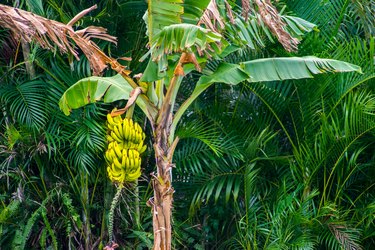
Edible banana plants (Musa acuminata, USDA zones 10-11) are large, herbaceous perennials that produce pseudostems from underground rhizomes. Pseudostems are fleshy, upright stalks that serve as the functional trunks for the plants. Each pseudostem produces only one banana cluster before dying; however, new stalks are continuously produced from the rhizome to take their place. Consequently, banana fruit production will continue indefinitely, providing cultural conditions are optimal.
Banana Tree Characteristics
Video of the Day
Mature bananas are 2 1/2 to 12 inches in length and 3/4 to 2 inches in width. Fruit peels are red, yellow or green, while the fruit flesh is a white or yellow color. The texture of the fruit begins firm and gradually turns more tender and slippery as it ripens.
Video of the Day
Banana plants are very fast growing. It takes anywhere from 10 to 20 months from planting until harvest and approximately 80 to 180 days from fruit shooting to harvest. This range is largely dependent on cultivar, growing conditions and temperature. Warm temperatures hasten banana tree blooming and fruit growth.
Pruning for Banana Fruit Production
Consistent pruning is needed for optimal growth and fruit production. If allowed, banana plants will produce an abundance of suckers. These suckers are pseudostems. The presence of excess suckers will result in smaller and lesser quality fruit, longer ripening times and higher incidence of disease.
For best results, remove extraneous suckers by chopping plants down and gouging out remains from below the surface soil level as soon as they develop. Allow no more than five suckers to surround the primary pseudostem at any one time.
When and How to Harvest
Harvest bananas when the fruit is fully developed but only 75 percent mature. The fruit should appear plump, rounded and light green in color. If the bananas are allowed to ripen on the stem and turn yellow, they may become mushy quickly. They may also attract rodents.
Cut banana bunches off leaving a foot or so of stem on when you do so. This stalk will allow you to hang banans upside down in a cool, shady location to ripen. Remove bananas from the stalk individually. Ripen them further by placing them in a paper bag for a day or two.
Avoid getting banana sap caused by cutting the stem on clothing when you harvest, as it causes permanent stains.
Post-Harvest Banana Tree Care
Following harvest, the pseudostem can be left standing for a few months to dehydrate before removal, or it can be removed immediately. A tool called a mattock, which is a combined axe and hoe, is used to remove the pseudostem in commercial operations. Best practices suggest cutting down the plant and spreading the felled pseudostem, as well as any other organic material, on top of the banana plant roots. Hard pack any remaining stumps to discourage pest infestation.
Banana plants are heavy feeders that respond well to regular fertilization. Fertilize banana plants monthly with a well-balanced organic fertilizer with low proportions of nitrogen-phosphorous-potassium, or N-P-K. This is stated on the label with numbers such as 6-2-4 and 4-4-4. Find organic fertilizers at stores like Home Depot, Amazon and Walmart.
Spread the fertilizer around the tree out to 4 to 8 feet (depending on the size of the tree). The bigger the tree, the further out you should fertilizer. Start spreading a foot away from the base of the tree.